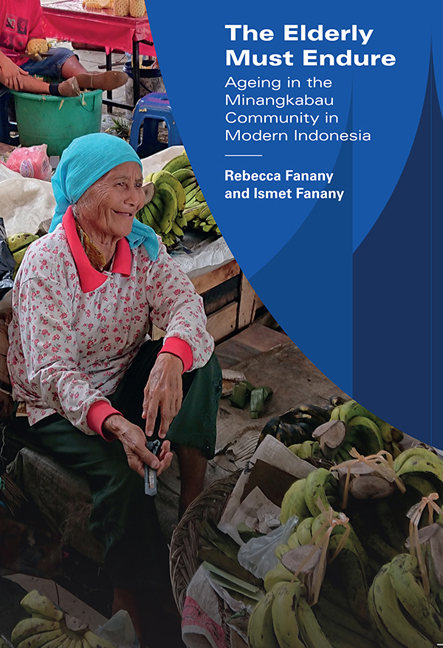Book contents
- Frontmatter
- Contents
- Acknowledgements
- Map of Indonesia
- Map of West Sumatra
- Map of the Village of Koto
- Aminah's Family Tree
- 1 Introduction
- 2 Ageing in the Past and Present
- 3 Adat Traditions and the Elderly
- 4 Religion and the Elderly
- 5 Language and the Elderly
- 6 Ageing in the Village
- 7 Ageing in Padang
- 8 Ageing in the Rantau
- 9 Ageing in an Institution
- 10 Ageing and Cultural Consonance
- 11 The Elderly Must Endure
- Afterword
- References
- Index
- About the Authors
2 - Ageing in the Past and Present
Published online by Cambridge University Press: 16 May 2019
- Frontmatter
- Contents
- Acknowledgements
- Map of Indonesia
- Map of West Sumatra
- Map of the Village of Koto
- Aminah's Family Tree
- 1 Introduction
- 2 Ageing in the Past and Present
- 3 Adat Traditions and the Elderly
- 4 Religion and the Elderly
- 5 Language and the Elderly
- 6 Ageing in the Village
- 7 Ageing in Padang
- 8 Ageing in the Rantau
- 9 Ageing in an Institution
- 10 Ageing and Cultural Consonance
- 11 The Elderly Must Endure
- Afterword
- References
- Index
- About the Authors
Summary
THE CONCEPT OF VILLAGE
The village, or kampuang, is the social unit that defines the living environment of people from West Sumatra. In addition to its obvious physical characteristics, the concept of the village is an important organizing feature in the way people think about themselves and others. One of the first questions people ask someone they just met is, Kampuang di ma? [Where is your village?]. Even though a large number of Minangkabau now come from large cities and the question really means “Where are you from?”, Jakarta or Padang has the same cognitive status as an actual village in the Minangkabau heartland in the mountains of West Sumatra. The village is a place to live but also an encapsulation of all the elements required for human existence in the Minangkabau context.
Until comparatively recently, the majority of Minangkabau really did come from a village or maintained a close relationship with the village of their ancestors. Folklore holds that all Minangkabau originated in one of three regions in the highlands of what is now West Sumatra. These areas are referred to as luhak and represent the original homeland of this ethnic group and the centre of its traditional culture. The myths of the region indicate that the Minangkabau came down from Mount Merapi to the area of Pariangan. Later, they spread out into the original luhak, and even later to the coastal plains which were the first rantau, an area outside of their region of origin that served as a destination for migration. This happened, according to legend, at an unrecorded point in the distant past sometime after the original settlement of the area, which took place when the volcanoes that form the backdrop for the Minangkabau world were only “as big as a duck egg”. Whether there is any truth to this idea, and if so, how much, cannot be discerned from the archaeological record of the region. However, it is the case that traditional literature, including proverbs and proverbial phrases, maintain the view that traditional customs and way of life developed in the highlands and spread down the mountains into the regions that have been inhabited by the Minangkabau in modern times. By contrast, newer influences of all kinds are seen as entering the Minangkabau world from the lowlands and travelling up the mountains into the traditional homeland regions.
- Type
- Chapter
- Information
- The Elderly Must EndureAgeing in the Minangkabau Community in Modern Indonesia, pp. 21 - 51Publisher: ISEAS–Yusof Ishak InstitutePrint publication year: 2018

